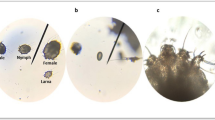Abstract
The development of five schistosome species was compared in mice by the recovery of schistosomula from chopped lung tissue and of adult worms by portal perfusion. Three developmental patterns appeared. (1) Schistosoma japonicum was unique in showing an early establishment of schistosomula in and a rapid departure from the lungs together with the highest worm recovery; (2) S. haematobium contrasted by establishing later and persisting in the lungs for at least 2 weeks while yielding the lowest adult worm recovery; and (3) S. intercalatum, S. mansoni, and S. rodhaini had an intermediate pattern – they resided in the lungs for several days, then disappeared and produced intermediate numbers of adults. Lung petechiae, known to accompany the migration of S. japonicum, were never detected after infection with the other species. We speculate that the three migration patterns of schistosomes are related to the size of the relative spectra of naturally infected definitive hosts.
Similar content being viewed by others
Author information
Authors and Affiliations
Additional information
Received: 31 August 1997 / Accepted: 15 October 1997
Rights and permissions
About this article
Cite this article
Rheinberg, C., Moné, H., Caffrey, C. et al. Schistosoma haematobium, S. intercalatum, S. japonicum, S. mansoni, and S. rodhaini in mice: relationship between patterns of lung migration by schistosomula and perfusion recovery of adult worms. Parasitol Res 84, 338–342 (1998). https://doi.org/10.1007/s004360050407
Issue Date:
DOI: https://doi.org/10.1007/s004360050407




